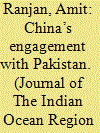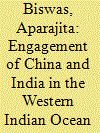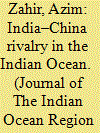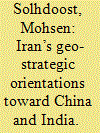|
|
|
Sort Order |
|
|
|
Items / Page
|
|
|
|
|
|
|
| Srl | Item |
| 1 |
ID:
179037


|
|
|
|
|
| Summary/Abstract |
Pakistan's closeness to China is mainly to balance a 'perpetual threat' from India that the Pakistani establishment has successfully instituted in the country over the years. To support Pakistan, China has been taking up a large number of projects in Pakistan that also strengthens its own political, economic and military position in South Asia. One such important project is a port at Gwadar in Pakistan's restive province of Balochistan. Although it is mainly projected as a commercial port, various reports in the international media claim that military facilities have been built at Jiwani, near Gwadar. This is, however, refuted by Pakistan and China. This paper discusses the trajectory of China-Pakistan relationships, looks at the nature of the Chinese engagements with Pakistan, examines the significance of Gwadar port for China and Pakistan, and analyses India's concerns and policy measures it has taken to address such concerns.
|
|
|
|
|
|
|
|
|
|
|
|
|
|
|
|
| 2 |
ID:
179033


|
|
|
|
|
| Summary/Abstract |
A significant development in contemporary times is the emergence of the Indian Ocean as an important economic zone and an area of intensifying rivalry between China and India. In this region, East African Indian Ocean littoral and island states have assumed importance because of their geo-strategic significance. Both India and China have increased their presence in the region and offered windows of opportunities to these states. While China’s intense relationship with the region began with the introduction of its One Belt One Road (OBOR) in 2013, India, on its part, has declared this region as a ‘top priority’ area in its foreign policy agenda. This article explores the driving factors behind the growing footprint of China and India in the Western Indian Ocean (WIO) littoral and island states in East Africa. While India and China have competing interests and strategies in this region, this article examines whether their increasing engagements bring development opportunities or pose challenges.
|
|
|
|
|
|
|
|
|
|
|
|
|
|
|
|
| 3 |
ID:
179032


|
|
|
|
|
| Summary/Abstract |
Sino-Indian relations have seen many ups and downs since the late 1940s. This paper surveys the bilateral relationship by considering their border dispute, status-competition, and economic relations before it examines various geostrategic points of contention, including: relations with Pakistan and the United States; bilateral water disputes; China's Belt and Road Initiative; nuclear weapons policies; and maritime competition in the Indian Ocean. The Galwan Valley incident in June 2020 – which saw Indian and Chinese soldiers killing each other with improvised weapons – is treated as an inflection point; thereafter the bilateral relationship has deteriorated from what T.V. Paul called a ‘managed and enduring rivalry' in 2018 into a ‘serious and enduring rivalry’ now. This finding provides wider context for the papers which follow in this special edition; these consider whether Sino-Indian rivalry presents, on balance, more opportunities or greater challenges to the smaller states in the Indian Ocean region.
|
|
|
|
|
|
|
|
|
|
|
|
|
|
|
|
| 4 |
ID:
179036


|
|
|
|
|
| Summary/Abstract |
After India's military intervention to thwart a coup in the Maldives in 1988, India had taken for granted its strategic relationship with the Maldives since the early 1990s. However, from around mid-2000s, Sino-Maldives linkages dramatically increased, threatening the Indo-Maldives strategic relationship. Yet, as a result of the growing Sino-Indian rivalry, Indo-Maldives strategic relations have also undergone substantive changes: from India as the de facto port of first call, to articulation of an ‘India First' policy in 2005, which then underwent substantiations, especially given China's Belt and Road Initiative, towards an ‘India dominated' strategic policy since late-2018. Consequently, even though Sino-Indian competition has provided significant economic opportunities to the Maldives, and the stability of the new Indo-Maldives strategic dynamic hinges on domestic factors, overall the Maldives’ foreign policy room for manoevre has been constrained. This case suggests that while external structural factors may not determine all foreign policy choices, they nevertheless significantly constrain the behavior of small states.
|
|
|
|
|
|
|
|
|
|
|
|
|
|
|
|
| 5 |
ID:
179035


|
|
|
|
|
| Summary/Abstract |
Iran is pulled in different directions by China and India when it comes to their rivalry in economic and geopolitical spheres. Yet, Iran – which initially exploited the Sino-Indian rivalry to maximize its benefits following the 2015 nuclear deal – has strived to navigate ties between China and India to survive in the face of tough U.S. sanctions since 2018. This article, first, provides a brief discussion on historical precedents that have shaped Iran’s foreign policy in general. Then, the pivots of Iran-China-India triangular relationship are examined by looking at Iran’s a) involvement in China’s Belt and Road Initiative; b) partnership with China in the Iranian oil fields; c) participation in India’s International North-South Transport Corridor; and d) partnership with India in the Chabahar port. Finally, Iran’s reorientation in response to former President Trump’s withdrawal from the 2015 deal and its reaction to President Biden’s possible return to the deal are discussed.
|
|
|
|
|
|
|
|
|
|
|
|
|
|
|
|
| 6 |
ID:
179038


|
|
|
|
|
| Summary/Abstract |
China and India's competition and power struggle in the Indian Ocean is the new geopolitical reality. The arrival of an extra-regional power and India's concern of a Chinese presence has given Sri Lanka leverage in realizing its domestic and foreign policy goals, and relative bargaining power in convincing New Delhi to realize its interests. Meanwhile China card has posed challenges. Colombo’s strategy vis-à-vis this dynamic is influenced by domestic and international compulsions. By adopting bandwagon, balancing and strategic hedging strategies of small states, this paper evaluates how Sri Lanka navigated the power struggle during 2005–2019. This period marks a major shift in the international attention towards the Indian Ocean and therefore to the island nation. The paper concludes that as power struggle has intensified India and China's engagement in Sri Lanka, it has also allowed Sri Lanka to realize its own goals and objectives.
|
|
|
|
|
|
|
|
|
|
|
|
|
|
|
|
| 7 |
ID:
179034


|
|
|
|
|
| Summary/Abstract |
The paper asserts that Bangladesh survives and thrives not only the global level power rivalry but also the interests of both China and India, especially in maintaining their presence and influence in South Asia and its adjacent regions. Bangladesh enjoys friendly and robust relations with two competing global powers in its geopolitical vicinity, India, and China. While Bangladesh has excellent bilateral ties with India and China, the bilateral relations of China and India suffer from tensions and mistrust. A growing literature on Sino-Indian relations has already pointed out their relations as ‘rivalry.’ In this context, the paper dwells on the key questions: What implications does the Sino-Indian rivalry bring about for Bangladesh? How is Bangladesh responding to those implications that Sino-Indian rivalry brings? How is Bangladesh shifting its strategic contours of relations with India and China towards a more cooperative framework? The paper argues that these questions are critical for understanding Bangladesh’s pursuit of adjusting to the emerging geopolitical environment marked by growing Sino-Indian rivalry .
|
|
|
|
|
|
|
|
|
|
|
|
|
|
|
|
|
|
|
|
|